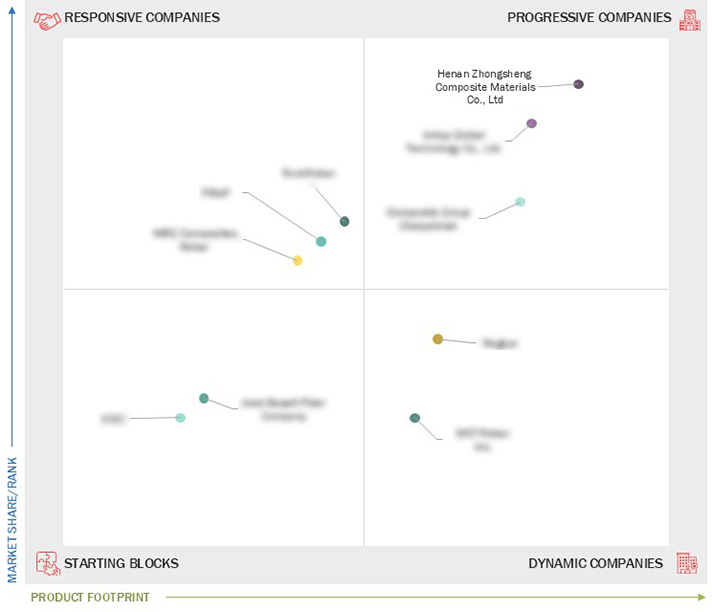Comparing 10 vendors in FRP Rebar Startups across 0 criteria.
FRP rebars are increasingly favored in construction due to their high strength-to-weight ratio, corrosion resistance, and flexibility in design. These materials offer a durable alternative to traditional steel rebars, especially in environments exposed to moisture and chemicals. Their adoption is growing in infrastructure projects like highways, bridges, and marine structures, driven by the need for long-lasting, low-maintenance solutions. Government regulations promoting non-corrosive materials and rising investments in civil engineering are further accelerating market growth, despite challenges like cost and limited professional expertise.
Market Leadership Quadrant
1.1 Study Objectives
1.2 Market Definition
1.3 Study Scope
1.3.1 Markets Covered and Regional Scope
1.3.2 Inclusions and Exclusions
1.3.3 Years Considered
1.4 Currency Considered
1.5 Unit Considered
1.6 Limitations
1.7 Stakeholders
2.1 Introduction
2.2 Market Dynamics
2.2.1 Drivers
2.2.1.1 Increasing demand in construction industry
2.2.1.2 Government-led regulations on use of FRP rebars
2.2.2 Restraints
2.2.2.1 Availability of substitute
2.2.2.2 High cost of FRP rebars
2.2.3 Opportunities
2.2.3.1 Rising investments in large-scale civil engineering projects
2.2.3.2 Growing use in construction of highways and bridges
2.2.4 Challenges
2.2.4.1 Supply chain and manufacturing constraints
2.2.4.2 Inability to completely replace steel rebar
2.3 Trends/Disruptions Impacting Customer Business
2.4 Value Chain Analysis
2.5 Ecosystem Analysis
2.6 Investment and Funding Scenario
2.7 Technology Analysis
2.7.1 Key Technologies
2.7.2 Complementary Technologies
2.7.3 Adjacent Technologies
2.8 Patent Analysis
2.9 Trade Analysis
2.10 Porter’s Five Forces Analysis
2.10.1 Threat of New Entrants
2.10.2 Threat of Substitutes
2.10.3 Bargaining Power of Suppliers
2.10.4 Bargaining Power of Buyers
2.10.5 Intensity of Competitive Rivalry
3.1 Introduction
3.2 Key Player Strategies/Right to Win
3.3 Revenue Analysis
3.4 Market Share Analysis
3.5 Company Valuation and Financial Metrics
3.6 Brand/Product Comparison
3.7 Company Evaluation Matrix: Startups/SMEs
3.7.1 Progressive Companies
3.7.2 Responsive Companies
3.7.3 Dynamic Companies
3.7.4 Starting Blocks
3.7.5 Competitive Benchmarking: Startups/SMEs
3.7.5.1 Detailed list of key startups/SMEs
3.7.5.2 Competitive benchmarking of key startups/SMEs
3.8 Competitive Scenario
3.8.1 Product Launches
3.8.2 Deals
3.8.3 Expansions
4.1 Antop Global Technology Co., Ltd.
4.1.1 Business overview
4.1.2 Products/Solutions/Services offered
4.1.3 Recent developments
4.2 Arab Basalt Fiber Company
4.2.1 Business overview
4.2.2 Products/Solutions/Services offered
4.2.3 Recent developments
4.3 Composite Group Chelyabinsk
4.3.1 Business overview
4.3.2 Products/Solutions/Services offered
4.3.3 Recent developments
4.4 FiReP
4.4.1 Business overview
4.4.2 Products/Solutions/Services offered
4.4.3 Recent developments
4.5 Henan Zhongsheng Composites Materials Co., Ltd.
4.5.1 Business overview
4.5.2 Products/Solutions/Services offered
4.5.3 Recent developments
4.6 ICSC
4.6.1 Business overview
4.6.2 Products/Solutions/Services offered
4.6.3 Recent developments
4.7 MRG Composites
4.7.1 Business overview
4.7.2 Products/Solutions/Services offered
4.7.3 Recent developments
4.8 MST Rebar Inc.
4.8.1 Business overview
4.8.2 Products/Solutions/Services offered
4.8.3 Recent developments
4.9 Regbar
4.9.1 Business overview
4.9.2 Products/Solutions/Services offered
4.9.3 Recent developments
4.10 RockRebar
4.10.1 Business overview
4.10.2 Products/Solutions/Services offered
4.10.3 Recent developments


 AInvest
AInvest
 Sep 2025
Sep 2025

